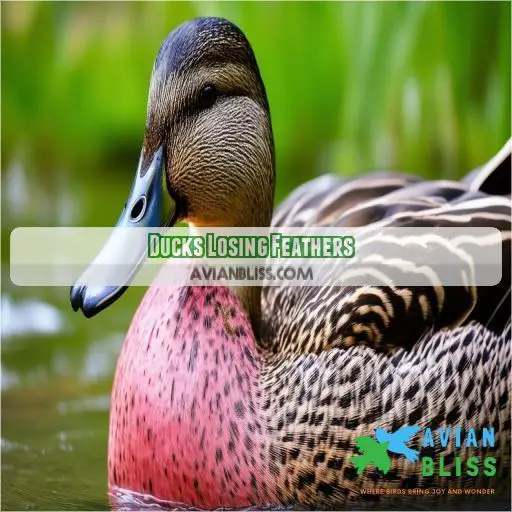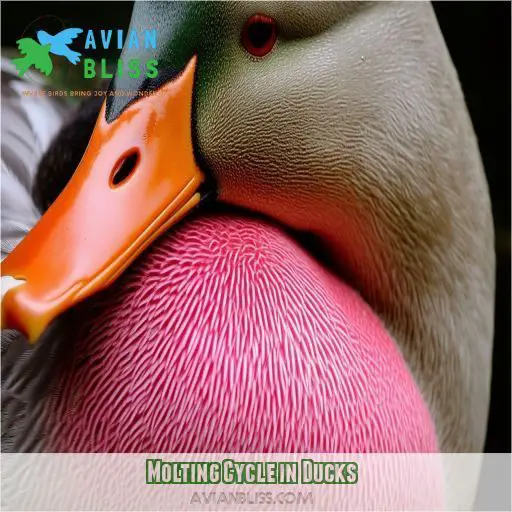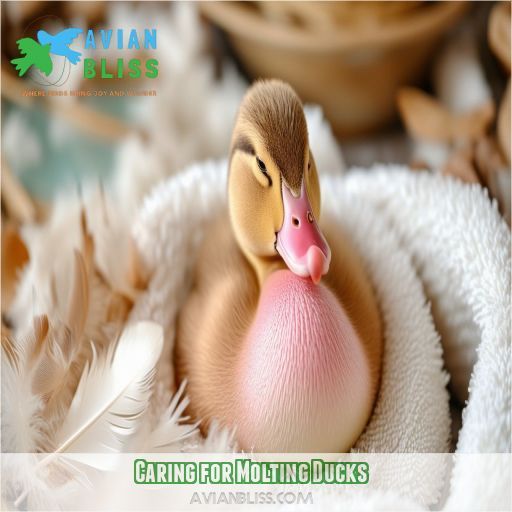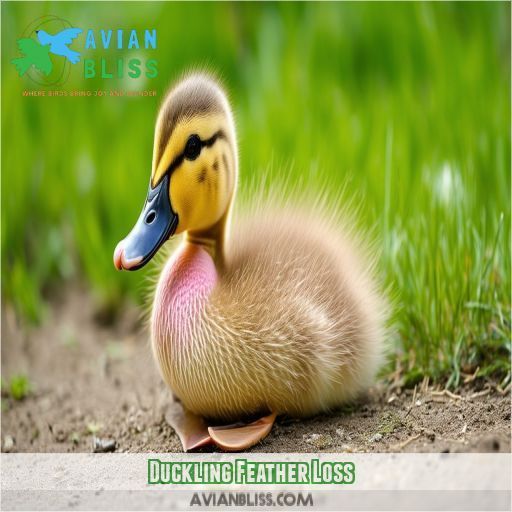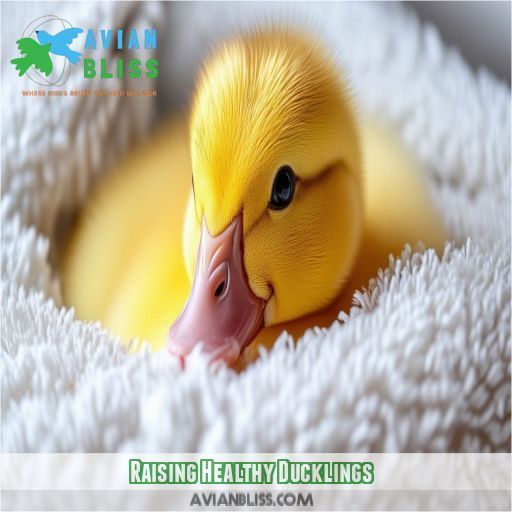This site is supported by our readers. We may earn a commission, at no cost to you, if you purchase through links.
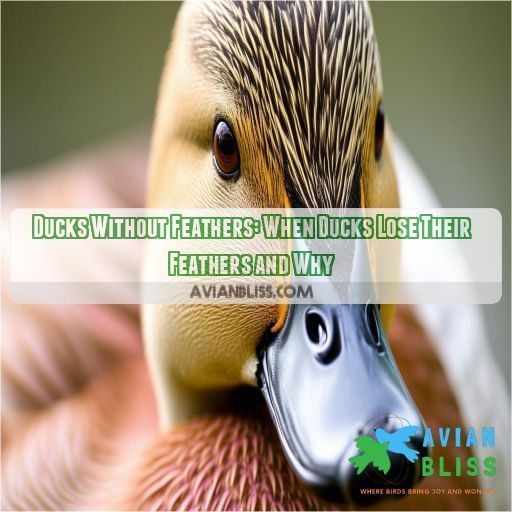
There’s also the natural process of molting, where ducks shed old feathers for new ones. This happens to ducklings, too, as they grow up. So, if you spot a featherless duck, it’s likely nature taking its course or a signal to check in with a vet. Want the full scoop?
Table Of Contents
- Key Takeaways
- Ducks Losing Feathers
- Molting Cycle in Ducks
- Caring for Molting Ducks
- Duckling Feather Loss
- Raising Healthy Ducklings
- Frequently Asked Questions (FAQs)
- Can molting ducks fly?
- What animal will take a whole duck?
- Do ducks lay eggs while molting?
- What do molting ducks look like?
- How do I know if my duck has a feather condition?
- How often should I bathe my duck?
- Is it normal for ducks to lose their feathers?
- What are the signs my duck is unwell?
- How can I help my duck regrow feathers?
- Conclusion
Key Takeaways
- Ducks can lose their feathers due to a condition called "wet feather," where their feathers become waterlogged, impacting their ability to stay dry and healthy.
- Molting is a natural process for ducks, where they shed old feathers and grow new ones. This occurs in both adult ducks and duckling development stages
.
- Bee the Duck’s story showcases the creativity and dedication of pet owners, as her owner crafted a custom raincoat to keep her dry due to her unique feather condition.
- Caring for molting ducks requires sensitivity and extra nutritional support, especially with protein-rich foods, to ensure healthy feather growth and overall duck wellness.
Ducks Losing Feathers
Have you ever spotted a duck that seems to be missing some feathers? Maybe you’ve wondered why they’re not always sleek and feathered. Well, there are actually a number of reasons why ducks might lose their feathers.
From seasonal moulting to health conditions, ducks can go through periods of feather loss, leaving them looking a little less than their usual fluffy selves. Let’s take a closer look at the reasons behind their occasional featherless state.
Wet Feather Condition Explained
Wet feather condition is a serious issue that can impact a duck’s ability to stay dry and healthy. Here’s what you need to know:
- Waterlogged Feathers: Wet feather condition occurs when a duck’s feathers become saturated with water, losing their ability to repel moisture.
- Swimming and Drying Challenges: This condition can make it difficult for ducks to swim effectively and dry themselves off, leaving them vulnerable to the elements.
- Potential Health Risks: Prolonged wet feathers can lead to health issues, as ducks may struggle to regulate their body temperature and become susceptible to illnesses.
- Feather Care and Grooming: Regularly checking your duck’s feathers for any signs of waterlogging is key. Provide appropriate care to keep them in good condition.
- **Prompt
Bee the Duck’s Custom Raincoat
Let’s turn our attention to Bee the Duck‘s custom raincoat, a story that’ll warm your heart and show you the power of creativity in action.
Bee, an adorable duck with a unique feather condition, struggled to stay dry. Her feathers, unfortunately, became waterlogged.
But worry not, because Bee’s owner crafted a clever solution: a custom raincoat. This wasn’t your average raincoat, folks. It was a clear coat with a stylish yellow trim, a necktie, and a hood.
Bee could now stay dry and look fly (pun intended). This heartwarming tale showcases the dedication of pet owners and the power of innovation.
Viral Sensation on TikTok
Bee’s raincoat has made her a viral sensation on TikTok, with over 12 million views. Her fashion statement has captured the hearts of many, and her story has spread beyond the platform. This showcases the power of social media to amplify unique stories and create viral trends, with Bee’s journey resonating with audiences worldwide.
Molting Cycle in Ducks
You might be wondering why your duck is looking a little sparse in the feather department. Well, wonder no more! Let’s take a closer look at the fascinating world of duck molting and explore the different cycles and patterns of feather loss and regrowth.
Eclipse Molt in Mallard Ducks
During the eclipse molt, male Mallard ducks, known as drakes, undergo a noticeable transformation. Here’s what you need to know about this fascinating process:
- Color Change: Drakes lose their vibrant nuptial feathers, resulting in a duller, more subdued color palette.
- Loss of Curly Tail Feathers: The distinctive curly tail feathers, which are a major attraction for female ducks, are also shed during this molt.
- Flightless Period: Due to a simultaneous wing molt, drakes become temporarily flightless.
- Camouflage Advantage: The eclipse plumage provides effective camouflage for both drakes and females, making them less visible to predators.
Nuptial Molt in Mallard Ducks
Let’s talk about a fascinating thing that happens with Mallard ducks called nuptial molting. This is when the drakes (male Mallards) get their fancy new feathers, which helps them attract the females for mating. It’s like their version of a fancy suit for a big date! This molt happens in late summer or early fall, and you’ll notice the drakes sporting brighter, more colorful feathers.
During this phase, females also undergo slight feather coloration and pattern changes. It’s like they’re getting a subtle makeover, too! But the focus of this molt is on the body feathers, not the flight feathers. So, the ducks can still soar through the skies without any issues.
Domestic Duck Molting Cycle
Domestic ducks often have different molting cycles than their wild cousins.
Even if they’re the same breed, they might molt at different times due to their cozy home lives.
Your pet duck might lay more eggs than a wild duck, which can throw her molting schedule off.
She probably won’t have a clear eclipse molt like wild ducks do because she’s got a fridge full of food and doesn’t need to migrate.
She might molt later in the year, thanks to her egg-cellent egg production.
Caring for Molting Ducks
Molting ducks require special care and attention. You’ll need to handle them with care, provide extra nutrition, and strike a balance with protein-rich foods to keep them healthy.
Sensitive Handling During Molting
Molting ducks can be a little more sensitive because of their new feathers coming in. Here’s what you need to keep in mind:
- Be extra gentle and cautious when you’re handling your duck during this time.
- New feathers can be delicate, so it’s best to avoid rough handling or stressing them out.
- Make sure your duck has a calm and comfortable spot so they feel safe during this process.
- Keep an eye on how they’re acting and how comfortable they seem, and change how you handle them based on what you see.
Nutrition Needs During Molting
When your duck is molting, they need a little extra nutritional TLC. Their diet plays a huge role in supporting healthy feather growth and overall health.
Protein-Rich Foods for Molting Ducks
When your ducks are molting, it’s important to give them extra nutritional support, especially protein-rich foods. Here are some tips to help you care for your molting ducks:
- Provide a waterfowl-specific feed that’s high in protein.
- Supplement their diet with fresh greens and treats.
- Offer treats like mealworms or crickets for an extra protein boost.
- Be careful not to overdo it on the protein, as too much can lead to health issues.
Avoiding Health Problems
Taking care of your molting ducks means keeping an eye out for health problems. Here are some tips to help you through this time:
| Tip | Description | Keyword |
|---|---|---|
| Handle With Care | Ducks can be sensitive to handling while molting because of their new feathers. Be gentle and try to handle them as little as possible. | Sensitive Handling |
| Nutrition Balance | Extra nutrition is important, but don’t go overboard with protein. Too much can cause health issues. | Nutrition Balance |
| waterfowl Feed | Give them a waterfowl-specific feed, and add fresh greens and treats. | Waterfowl Feed |
| Protein Sources | Offer extra protein like mealworms or crickets, but make sure it’s not too much. | Protein Sources |
Duckling Feather Loss
Ducklings losing their feathers can be a normal part of their development, but it can also be caused by other factors like illness. In this section, we’ll explore the different reasons why ducklings might lose their feathers and provide you with the knowledge to support their feather growth and overall health.
Normal Molting in Ducklings
Ducklings typically start molting around 4-6 weeks old.
They lose their first fluffy feathers and grow more mature feathers.
It’s a natural process that helps them change from adorable fluff balls to sleek-feathered swimmers.
Don’t worry if your duckling seems a bit feather-challenged during this phase; it’s all part of their development.
Within 2-3 weeks of starting to molt, they’ll have most of their new feathers, and they’ll continue to develop and refine their feather coat over time.
Feather Loss After Illness
Besides the normal molting process, ducklings can experience feather loss due to illness. If your duckling has a respiratory infection, the medication used to treat it may contribute to feather loss. This is a normal part of their recovery process, and their feathers should grow back within a few weeks.
Feather Growth and Development
Ducklings will typically start to grow new feathers around 4-6 weeks old. This process can take a couple of weeks, and you should see most of their feathers within this time frame.
You can expect:
- Growth Spurt – Ducklings will go through a rapid growth phase, sprouting new feathers.
- Fuller Feathers – Over time, these new feathers will fill out and become more defined.
- Color Development – The true colors of the duckling’s feathers will emerge as they mature.
Full Feather Development in Ducklings
Once ducklings have most of their feathers grown in, they continue to develop and refine their plumage. This process helps them get a full, healthy coat of feathers.
| Week | Duckling’s Age | Feather Development |
|---|---|---|
| 1 | 4-6 weeks | Initial feather loss and growth |
| 2-3 | 6-9 weeks | Feathers mostly grown in |
| 4-5 | 10-12 weeks | Full feather development |
| 6-7 | 12-14 weeks | Feathers refined and matured |
| 8+ | Adulthood | Regular molting cycles |
Ducklings typically reach full feather development around 10 to 12 weeks of age, though this timeline can vary slightly depending on their breed and individual growth rate.
Raising Healthy Ducklings
So, you’ve got yourself some ducklings and want to raise them into healthy, happy ducks? You’re in the right place. We’ll take you through the ins and outs of duckling care, from getting them comfortable with humans to making sure they’re healthy and well-fed.
Duckling Quacking and Vocalization
Ducklings typically start quacking around 10 to 12 weeks old, but some may begin earlier. Here are a few things to keep in mind:
- Duckling Vocalization: Before they’re fully developed, ducklings may make small quacking sounds, so don’t be surprised if you hear peeps and chirps from them.
- Typical Quacking Age: On average, ducklings will start quacking around the 10 to 12-week mark.
- Early Quackers: Every duckling is unique; some may start quacking earlier than the typical timeframe, so don’t worry if your duckling is a bit of an early bird when it comes to vocalization.
Handling and Socialization
Ducklings can be scared of being picked up, especially if they’re not used to it.
You can help them get comfortable with gentle handling and positive reinforcement.
The more you handle them, the less fearful they’ll be, and they’ll be easier to manage as they grow up.
It’s a bit like teaching a puppy not to be afraid of the vacuum cleaner – gentle exposure makes all the difference!
Creating a Bond With Ducklings
If you’re keen on raising healthy, happy ducklings, you’ll need to create a bond with them. How? Through regular interaction and handling, that’s how.
It’s simple: the more you hang out with your ducklings, the more they’ll get used to you. They’ll be less scared and easier to handle as they grow up. So, don’t be a stranger—get in there and socialise with your feathered friends!
Duckling Care and Nutrition
Now that you’ve bonded with your ducklings, it’s time to focus on their care and nutrition to help them grow into healthy adult ducks. Here are some key things to keep in mind:
- Provide a clean and safe environment: This includes hay bedding, clean water, and a heat lamp to keep them warm.
- Balanced diet: Offer a diet specifically formulated for ducklings, supplemented with fresh greens and treats.
- Socialization: Continue to handle your ducklings regularly to help them become comfortable and friendly around humans.
- Observation: Keep an eye on their behavior and appearance for any changes, and consult a veterinarian if you have any concerns.
- Online resources: Utilize online communities, forums, and veterinary websites to learn from other duckling owners and experts.
Health Monitoring and Veterinary Care
As a responsible duckling caregiver, you should be vigilant about health monitoring.
Keep an eye out for any signs of illness, such as sneezing, gasping for air, or lethargy.
If you notice any unusual behavior or appearance changes, it’s important to consult a veterinarian.
Online resources, veterinary websites, forums, books, and experienced duckling breeders can also provide valuable insights.
Frequently Asked Questions (FAQs)
Can molting ducks fly?
Molting ducks may have a harder time taking flight. During an eclipse molt, drakes lose their flight feathers and become flightless. So, if you spot a duck mid-molt, it might be taking a break from soaring the skies.
What animal will take a whole duck?
A whole duck? That’s a feast for some snakes, hawks, falcons, fish, and even the Great Horned Owl. These predators have different hunting styles, but they’re all keen on duck for dinner.
Do ducks lay eggs while molting?
While it’s taxing on a duck’s system to lay eggs and regrow feathers, it’s not clear if ducks stop laying eggs while molting. Broody ducks stop laying when they sit on a nest, but this isn’t always the case.
What do molting ducks look like?
During molting, ducks can look grumpy and have engorged new feather shafts that are sensitive to touch. Drakes’ eclipse plumage is muted and dull, acting as camouflage.
How do I know if my duck has a feather condition?
Imagine your duck’s feathers looking limp and bedraggled, unable to shake off water. That’s a sign of a feather condition like Bee the viral duck’s. Keep an eye out for changes in feather appearance and texture.
How often should I bathe my duck?
As waterfowl, ducks should have access to clean water to bathe in whenever they need. This keeps their eyes, nostrils, and feathers clean and healthy. If you can’t provide continuous access, aim for a weekly bath.
Is it normal for ducks to lose their feathers?
Yes, it’s normal for ducks to lose their feathers. It’s called molting, and it happens twice a year for wild ducks. Domestic ducks might molt at different times due to their environment and diet.
What are the signs my duck is unwell?
If your duck is unwell, they might be reluctant to walk or lame. They could have abnormal poop, cloudy eyes, or a discharge from their nose. Other signs include lethargy, ruffled feathers, and a drop in egg-laying.
How can I help my duck regrow feathers?
Make sure your duck stays dry for a few days, then gradually reintroduce swimming. A protein-rich diet will also help. Try a waterfowl-specific feed, mealworms, or crickets to support feather regrowth.
Conclusion
Ever seen a duck looking like it just walked out of a rainstorm, feathers all soggy and messed up?
You might wonder, "Why are some ducks without feathers?" Well, there’s a good reason.
You’re about to learn about the challenges of wet feathers and the natural molting process.
You’ll also pick up tips on caring for molting ducks and ducklings, making sure they thrive through feather loss.

